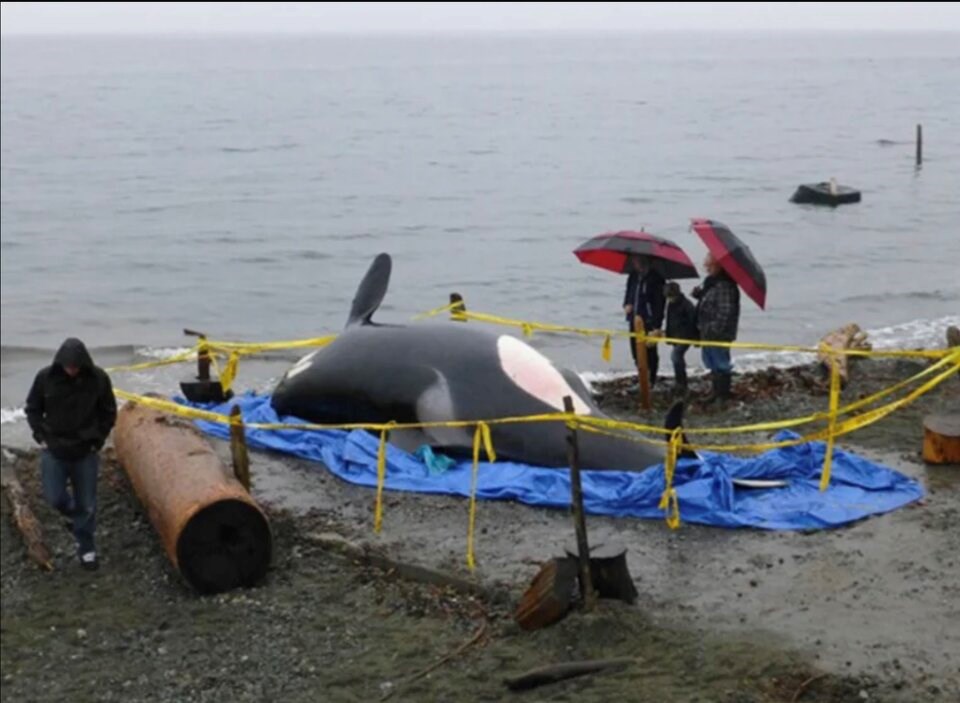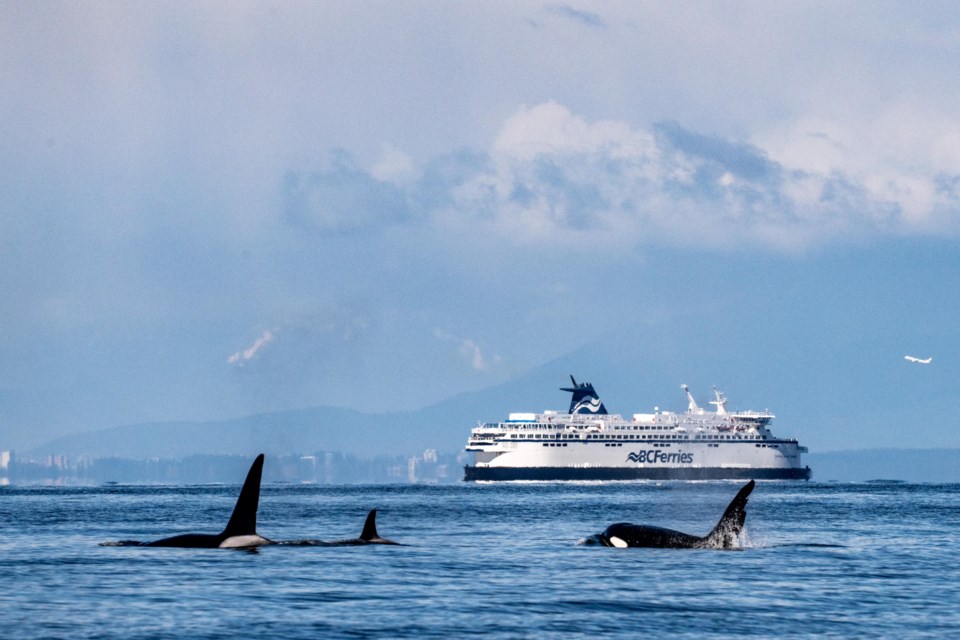British Columbia’s killer whale populations are absorbing toxins from wildfire smoke and oil spills, a new study has found.
The research, published in the journal Tuesday, analyzed skeletal muscle and liver samples from Bigg’s killer whales and endangered southern resident killer whales stranded over more than a decade.
In at least half of the samples analyzed, researchers found 38 toxic polycyclic aromatic hydrocarbons, or PAHs, a component of gasoline, crude oil, and coal also formed by burning organic matter like fossil fuels or wood.
Juan José Alava, an author on the study and a principal investigator at the University of British Columbia’s Ocean Pollution Research Unit, said the study showed how killer whales can act as a “canary in the coal mine” indicating how toxins from oil, coal and wildfires are impacting oceans.
“This is part of what we call bio-accumulation of pollutants via the food web,” said Alava. “We know the hydrocarbons are toxic. They persist in the environment.”
“They conspire together to affect the survival of the species.”
Science more than a decade in the making
The study examined beached whales from two populations off the coast of British Columbia: six Bigg’s killer whales — a transient species that hunts marine mammals — and six endangered southern resident killer whales, whose population has stagnated at 73 or 74 individuals.
Paul Cottrell, who works with Fisheries and Oceans Canada’s BC Marine Mammal Response Unit and co-authored the study, said the research offers a baseline that will allow scientists to track the rise of PAHs for years to come.
Cottrell described the research as the culmination of a more than decade of recovery work. Sometimes he and his team would get word of a beached or floating whale, and they would only have a couple of hours to jump in a boat or float plane.
In 2014, Cottrell rushed to reports of a female whale floating off Comox. Then he saw the photo.
“‘Oh my gosh,’ I thought. ‘We’ve got a dead killer whale,’” he said.
It was J32, or Rhapsody, pregnant and in the prime of her life. When they finally dragged her to shore at Bates Beach near Courtenay, and opened her up, they discovered her breached fetus had gone septic. Later it was found she had been . They took several samples and put them on ice.

Nine years later, those samples show evidence the toxic hydrocarbons had been transferred from the mother to her fetus, a sign that human's use of fossil fuels — in particular, the combustion vehicle and crude oil — “are negatively impacting these top predators,” found the report.
Other whale carcasses Cottrell attended to over the years showed similar signs of the toxic chemical.
A whale known as Luna had spent five years in Vancouver Island’s Nootka Sound after being separated from his mother, only to be killed by a tugboat in 2006. His tissue samples showed signs of PAHs from petroleum, coal and wildfires. While there, Luna “had extensive human interaction,” including “close contact with humans, urbanization, and industries,” the report noted.
In 2016, J34 was found dead five nautical miles offshore of Sechelt in “crazy weather,” and only made it to shore with the help of a Coast Guard boat, said Cottrell.
The cause of death: after a collision with a vessel. It must have been quick, said Cottrell.
While the Sechelt First Nation preserved the skeleton, UBC researcher Stephen Raverty took multiple muscle and liver samples, freezing them at negative 80 degrees Celsius. At the time, Cottrell said it wasn’t clear what they could learn from the samples. Now, years later, all the work paid off.
“It's thinking ahead and being able to store and have this archive that enables this kind of work,” he said. “If you don’t have a baseline, you don’t know the trends going forward.”
Southern resident killer whales contain more fossil fuel toxins
In the past, scientists understood that PAHs have been known to make their way into the Salish Sea through creosote treated railroad ties, power poles, and marine pilings.
But the latest baseline study suggests the toxins found in the whales could have entered their marine environment through deposition from the atmosphere or runoff from rivers.
The samples from the Bigg’s killer whales, who have a wider range, were found to contain more toxins from wildfires. The southern resident killer whales, meanwhile, were found to have higher concentrations of the PAH toxins that came from fossil fuels like oil or coal.
The researchers suggest the difference comes down to range. Southern resident killer whales tend to live near urban and industrial areas like Vancouver and Victoria, where dense human settlement combines with wastewater discharged from ships, and where coal and oil is spilled as they are loaded at port.
A 2017 from the International Council on Clean Transportation claimed 35 million tons of washwater — PAH-containing exhaust gas from ship cleaning systems — was discharged in B.C. waters.
“An estimated 10 [per cent] of this discharge was released into SRKW [southern resident killer whale] habitat,” wrote the researchers.
A chemical cocktail
Once in the ocean, PAHs tend to stick to particles and sink through the water column, where they can be ingested, inhaled or absorbed through the skin of animals, causing “acute or chronic toxicity.”
Past research has shown PAHs are also carcinogenic, can trigger mutations, suppress an animal’s immune system, and can disrupt endocrine systems in marine mammals, the study notes.
In other whale species, such as Beluga whales in the St. Lawrence River, PAH has been causally linked to cancer development.
And following the 2010 in the Gulf of Mexico, another study found an exposed species struggled to move, and faced impaired adrenal gland function, cardiotoxicity, immune system dysfunction, and the disruption of blood cell function. The most exposed animals suffered multi-organ system failure.
Chemical pollutants are among the top three primary threats to the survival of southern resident killer whales, the other two being access to chinook salmon, its preferred prey, and noise and physical disturbances from humans.
Christianne Wilhelmson, executive director of Georgia Strait Alliance, who wasn’t involved in the study, described the research as “powerful” and evidence of the “strain the species is under.”
“What they have in their bodies is running through the food chain,” Wilhelmson said, pointing to a number of previously studied pollutants.
The includes a number of forever chemicals, from the banned nerve poison DDT to . Together, they could have a powerful impact on the ability of the southern resident killer whales to rebound from stagnation.
Alava said he hopes his team’s research reaches policymakers in government to stem the flow of toxins into the marine environment.
“Now we have a chemical that’s related to every level of the fossil fuel industries,” Wilhelmson added.
“If we don’t take bolder action on fossil fuels, if we don’t take bolder action on pollution, this species is going to disappear.”




